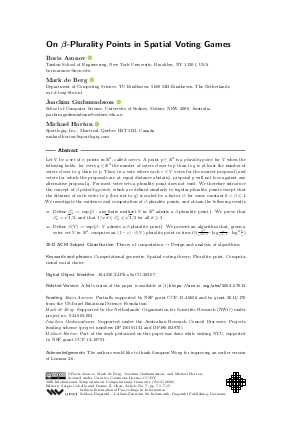@InProceedings{aronov_et_al:LIPIcs.SoCG.2020.7,
author = {Aronov, Boris and de Berg, Mark and Gudmundsson, Joachim and Horton, Michael},
title = {{On \beta-Plurality Points in Spatial Voting Games}},
booktitle = {36th International Symposium on Computational Geometry (SoCG 2020)},
pages = {7:1--7:15},
series = {Leibniz International Proceedings in Informatics (LIPIcs)},
ISBN = {978-3-95977-143-6},
ISSN = {1868-8969},
year = {2020},
volume = {164},
editor = {Cabello, Sergio and Chen, Danny Z.},
publisher = {Schloss Dagstuhl -- Leibniz-Zentrum f{\"u}r Informatik},
address = {Dagstuhl, Germany},
URL = {https://drops.dagstuhl.de/entities/document/10.4230/LIPIcs.SoCG.2020.7},
URN = {urn:nbn:de:0030-drops-121651},
doi = {10.4230/LIPIcs.SoCG.2020.7},
annote = {Keywords: Computational geometry, Spatial voting theory, Plurality point, Computational social choice}
}

 Creative Commons Attribution 3.0 Unported license
Creative Commons Attribution 3.0 Unported license



























